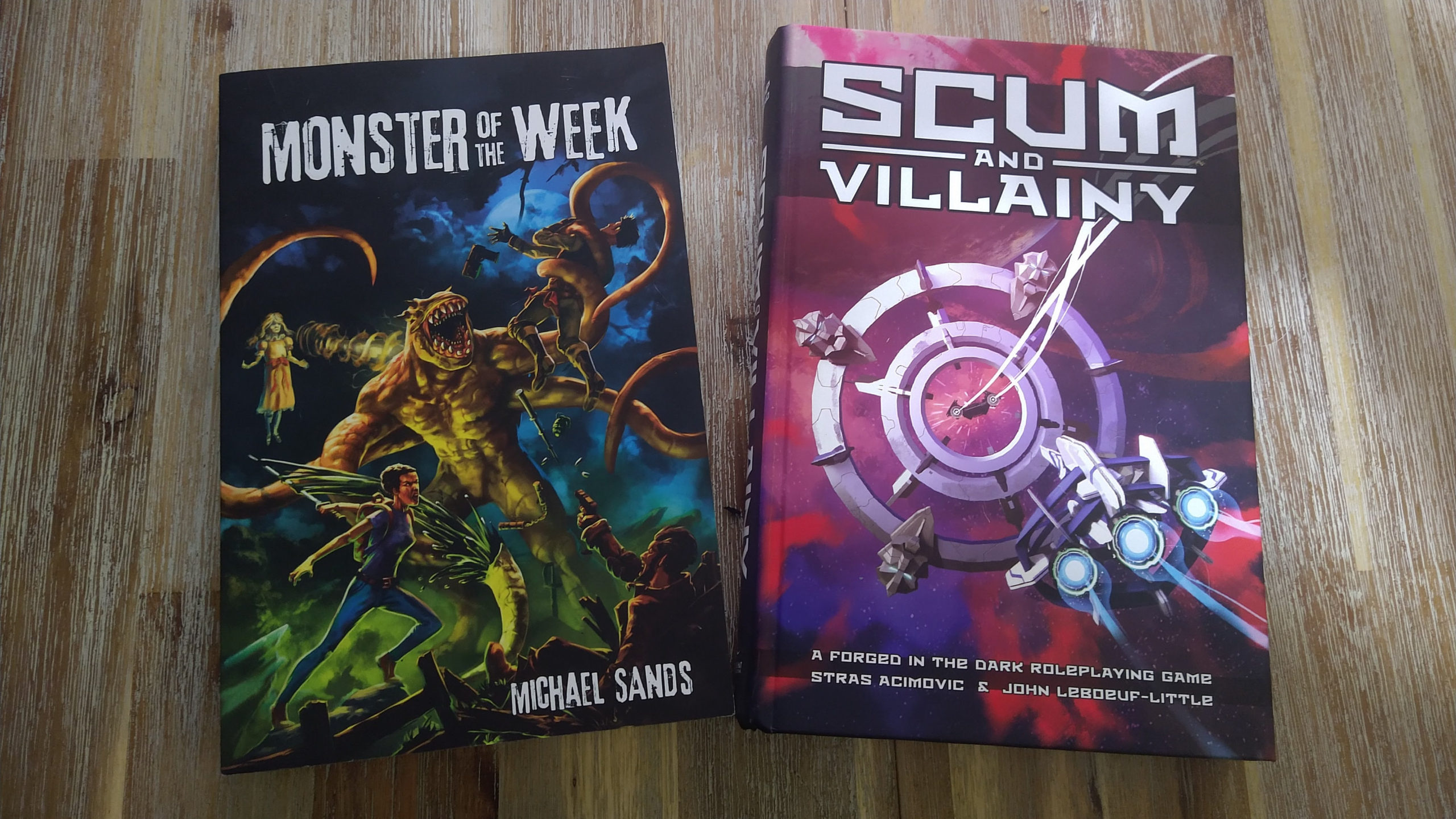How did this begin? In truth, it began a while back when I played Dungeon World. It really started after playing Blades in the Dark and picking up Monster of the Week after hearing some good stuff about it.
Anyway, that got me thinking about the differences between Forged in the Dark and Powered by the Apocalypse systems and here we are.
What are you doing!
Once I maintained a database of PbtA games at this location, but I fell behind and now there are, friends, I kid you not, hundreds and hundreds. Too many to catch up!
http://apocalypse-world.com/
The impossible apparently, not without a lot of reading. One thing starting this has highlighted is how many PtbA games there are actually are. They’re like a virus. Even an author of the engine has stopped keeping track. Literally hundreds, apparently. We have to be realistic about what’s happening here. This comes down to what I’m comparing and why.
In terms of what I am comparing its primarily Dungeon World and Monster of the Week (Powered by the Apocalypse herein PbtA) to Blades in the Dark and Scum & Villainy (Forged in the Dark herein FitD). I have those books and I’ve played all of them but for Monster of the Week. Realistically, that is primarily what I’m doing.
Tangentially I’m also aware of Urban Shadows and Masks with respect to PtbA so those may occasionally get mentioned, more specifically Masks. There is literally no way I can account for, or include, all the infinite variation that has probably arisen within the PtbA landscape.
In terms of why the aim is obviously not to deliver the ultimate researched and complete comparison and breakdown. I suspect you could get astronically closer to that without reading every game, but it’s not that so put it to one side. The lens to view this through is me assessing the sort of things I prefer from both engines, which is limited by what I’ve experienced or read and very much in the context of possibly running one of them.
I think it’s still useful, it just can’t be complete. Keep that in mind. If it spurs a Twitter discussion of some of infinite variety in PtA games that’s also perfectly fine.
Where I’m coming from
My gaming sweet spot is definitely Fate and Cortex Prime. Games that use a traditional gaming structure but are defined under fiction first rules. They also happen to be generic but I don’t believe that’s a factor. I like them because the rules deliver fiction first but don’t really hard move into what shape that fiction should take beyond, say, the general ethos of Fate characters being proactive, dramatic and competent (which is just Homo Fictitious expressed another way).
The lens of this article is very much me working through whether these systems will feature in the next thing I run. It’s only part of it though, another angle is what my approach to that would be should I decide to go for it, but that’s for the future.
The approach
This article is going to be defined by structure and decisions. In terms of the structure, I’m breaking the FitD and PbtA down into: –
- The playbooks
- The play structure
- Taking action
- The experience loop
- The advice
When it comes to each of these sections I’m going in hard on making a binary choice: –
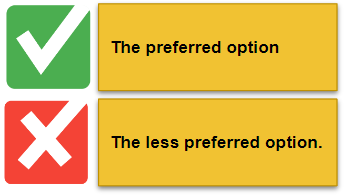
I’m doing this to be clear initially and also people like a bit of controversy. Anyone who comes here often knows I also believe the context is King so there will obviously be enough explanation of why I prefer one over the other and how close or not the call is.
Where both are similar
It’s worth calling out the similarities between both PbtA and FitD since there are people who literally argue they are the same and other people find the systems interchangeable to the degree they forget which system powers which games.
This means at some level they do appear similar. FitD was also inspired by PbtA so there is some of the DNA from the former in the latter.
The similarities are: –
- They are both fiction first
- They both focus on play to find out
- They both use playbooks
- They both use success, but
- The experience loop is similar but not
That’s it, but behind that, they are very different to the extent I believe it’s possible to be enamoured with one and dislike the other. I suspect it’s also possible to love one PtbA game and detest another due to the variety. So, you can say they are similar but I don’t believe you can say they are the same. Well, you can, but lots of things are the same if you sample them at a high enough level of abstraction.
A level that can be useful but is also reductive.
The Playbooks
I’m willing to admit it took me a while to come around to playbooks, primarily because I didn’t find the Dungeon World ones that inspiring and I can’t even remember the Urban Shadows ones.
I didn’t like playbooks until I saw the Fate version of them in Dresden Accelerated. I loved those. I then read the ones in Scum & Villainy and then Blades in the Dark and I came around while keeping a wary eye on those PbtA ones.
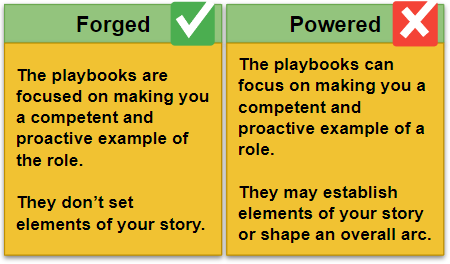
The primary problem I had with playbooks, and still do in some incarnations, was how PbtA implemented them. I felt like they were telling me who my character was.
Some PbtA playbooks give you a name to pick and / or a look. Never tell me my character’s look as I’m big on the visual role-playing of character so that’s a trigger point. I do realise these are meant to be quick ways in and you can ignore them and come up with all that stuff yourself – but it annoys me as it smacks of the whole one-shot ethos that sometimes comes across in PbtA which chafes at me.
It literally only takes a few people to just lazily run with these options and the experience has been cheapened for me.
Sometimes, not always, PbtA playbooks move into defining elements of the protagonist’s story not just what they are. As an example, a FitD space opera Smuggler playbook will make you a competent, proactive and (not so much dramatic) Smuggler while Powered may do that but also have the playbook tell you that ‘you are involved in an on and off romantic relationship with a person above your station’. Masks does this sort of thing with some playbooks.
Powered can also have moves which just don’t make you just a component ‘something’ but dictate your actions in the game in a repetitive fashion. I understand that these are often (1) staples of the Playbook characters in fiction and (2) are also present, in some cases, so the Playbook can generate experience in different ways to making rolls – but I still don’t like it. I don’t want my experience to be tied to doing ‘tired action X’ every session.
In FitD the style of fiction is more embedded in the structure of the game, while in PbtA the essential style of the fiction is more likely to be found in the playbooks. This is the case in Masks which has the teenage superheroes fiction style embedded into the playbooks to such an extent the broad meta-arc of the character’s story can be found in the playbook.
Despite knowing why they do it I literally cannot stand it.
Not all PbtA Powered games do this, Monsters of the Week playbooks are much closer to FitD ones. I’m also sure, out there in the vast PbtA landscape, there are games which shift things into the structure a bit more like FitD.
The Play Structure
This one is interesting, but I said I’m always going to make an initial binary choice and I’m sticking with it. Forced into this choice I had to pick PbtA, primarily because it doesn’t really have a structure. You just play like any other role-playing game just in a highly fiction first, player-facing form (the fact you model it via moves we deal with in Taking Action).
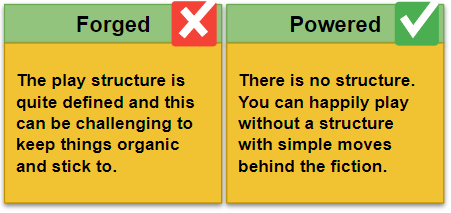
FitD lost by virtue of having a quite specific structure. Context is important though so let’s get into that.
The problem with structure
Note: I’ve thought of this more since writing this article and have come to frame the whole structure as always being in free play and you just have some extra tools at times. This is in line with the more conceptual take on the structure.
The structure of both Blades in the Dark and Scum & Villainy is outlined below. You engage in some free play, transition into a job and then come out the other end and via downtime. Repeat.

The problem I have with games that run the experience through a defined structure is what I call The iZombie Problem. iZombie was a great show but it followed a structure that go so repetitive it didn’t matter how good the opening theme was or the cast or the concept it just felt the same every week. This meant I slowly stopped watching it.
Somewhere in the structure, the emotional heartbeat of the story can get lost.
The phases are a conceptual model to help you organise the game – they’re not meant to be rigid in structure.
– Scum & Villainy
I know, before people point it out, there is the idea these phases are somehow conceptual and aren’t as restrictive as they appear. I agree…to a degree. The trouble is it happens, don’t say it doesn’t. It also means not falling into the trap becomes an active part of the experience! If I decide to run Scum & Villainy getting the most out of the structure and retaining the emotional heartbeat of what was being created would be something I’d need a strategy for.
Taking Action
FitD wins simply because I think its approach to taking action is a thing of beauty. It’s not that PbtA is terrible, it’s just the approach of Forged in the Dark is really good.
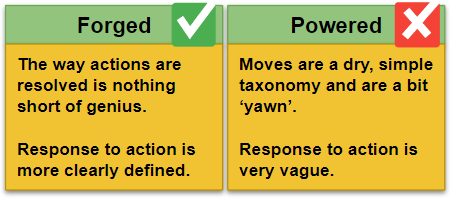
Forged taking action
The approach taken is really clever because the whole thing is a glorious abstraction while addressing some of the challenges with games that allow abstracted stats or any skill to address any problem models of play.
The genius is the abstraction of: –
- Stress
- The short action (sort of skill) list
- Position and effect
I just love how these three things combine.
The singular resource of stress to allow you to succeed at the fiction you see as important, avoid the fiction you don’t like, empower the more impactful flashbacks and whatever else is very clever. It’s a ludicrous level of abstraction but works for me.
Removing the need to handle difficulty numbers by instead deciding if the fiction is controlled, risky or desperate is elegant. It’s substantially more frictionless than changing difficulty numbers, makes more sense, gives a sense of urgency to desperate rolls and links into the experience loop. As a piece of modelling its genius.
Should it be hard to accomplish something by action (skill) A than B? Always a thorny one in some systems with a high level of abstraction while allowing player authoring to define what skill to use. In FitD it’s easy just decide the level of effect as limited, standard or great. Done. Let the player decide to run with it or not. Brilliant.
I’d also say, while introducing a bit more friction into the experience, assembling the dice pool and choosing whether to have a Devil’s Bargain makes the process more interesting.
I could literally gush about this all day.
Powered taking action
How do I describe my feelings here in a concise manner? I admit it is challenging. I think my main challenges are I find the moves just a bit dry and the need to codify the whole tabletop role-playing game into moves slightly funny.
The latter is particularly true of the GM moves which trend into the territory of trying to codify literally everything the GM might do. This codification allows the text to put into words the types of things the GM can do in response to player actions in the fiction clearly but it’s still all a bit odd seeing organic story stuff sort of itemised out as a list of specific moves. I realise you don’t speak in moves at the game, but it’s still odd.
There is nothing wrong with how action is taken in PbtA I just find it a bit less interesting. I just can’t get myself excited about how the players use moves to progress things in the PtbA games I’ve read or played. There is something about the way FitD does it that makes it exciting, less so for PtbA. So far anyway, I’m sure at some point that will change.
The experience loop
FitD and PbtA have experience loops and the elements of the loop are based on similar things but there are subtle differences. It’s been a hard one to make the binary choice on as the DNA of either of them doesn’t sit perfectly with me.
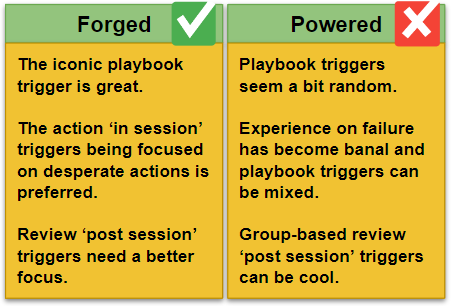
The experience loop has characters earn experience from three sources: –
- Playbook
- Actions ‘in session’
- Review ‘post session’
The reason I’ve gone for FitD is I prefer the playbook and action ‘in session’ in FitD and while PbtA does something I like in the review ‘post session’ triggers FitD is more personal and would be great with some improvements.
This is definitely where a lot of PtbA games vary. As an example, Masks doesn’t have doesn’t have review ‘post session’ triggers at all. It’s also the case different PbtA games will have potentially infinite riches in playbook triggers and the the types of actions that can trigger ‘in session’ experience.
Playbook experience triggers
The playbook triggers in FitD are clear, consistent and present for every playbook. They sit at the top of the playbook in a ‘when you address a challenge through’ pattern which also makes them iconic to a playbook while leaving how it happens open. It is elegant.
Playbook triggers are less clear in my PbtA experience. In Monsters of the Week some have such triggers and some do not. Some are even for rather innocuous reasons like the ‘and followed your advice’ trigger on The Expert’s Often Right move. I tend not to like those types. I can’t help feeling this will create a very uneven experience progression. It’s not consistent across games though as Dungeon World doesn’t have any playbook xp triggers.
I’ll always prefer an evocative ‘in the style of’ approach and for them not to be spammable and triggered multiple times. I even had this problem with incarnations of Cortex Prime, like in Marvel Heroic Role-Playing where characters had at least one trigger they could spam infinitely.
Actions ‘in session’ triggers
This is a basic question: do you prefer an xp trigger on every failure or when you perform a desperate action whatever the result?
I prefer the latter as the xp trigger on failure has just become a bit banal to me. It’s just a bit ‘yeah whatever’ and also open to becoming a bit of a running joke. It certainly became that in Dungeon World due to the WIzard tracking ahead due to failing a lot. It feels like it’s a reward for frustration.
The FitD model is ace though as it drives the characters to try desperate actions but they can have serious consequences on failure. It supports the narrative. It drives it in the right direction. It juices the desperate rolls. It’s a much better way of doing it.
Review ‘post session’ triggers
I have a strange relationship review ‘post session’ triggers. Despite the process supposedly being one of positivity and affirmation I get frustrated with the process and tend not to enjoy it some of the time. It can occassionally be a moment of minor gaming dread.
I think whether I enjoy it or not comes down to the quality of the questions and the metrics the questions are based on.
There is a distinct difference between the FitD and PbtA games I’ve read or played. If PbatA games have these triggers they’ve tend to be triggers for the group so far and then everyone marks the same amount of experience. I do like that, a lot. FitD games are individual questions. This does mean the former maintains group parity and the latter creates a bit of an experience race but can be more personal.
What I’m ultimately looking for is these review ‘post session’ triggers to be intimately linked to the meaningful why, sometimes they miss the mark to different degrees because the metrics are off or because the questions are more focused on ensuring genre things have happened. If I was to move to running and review ‘post session’ triggers are thing this better linkage would be a focus.
The advice
The advice for players and GMs alike is notorious in both game systems. They’re notorious in how good the advice is. They definitely fall into that category of games that everyone should read just to see how it influences how they game generally even if they put the book on a shelf and never play it.
Making the binary choice for this section is interesting as I come to the books as someone with nearly 40 years of experience across numerous role-playing games and have got to play to find out and fiction first through practical experience and other sources. This means the FitD and PbtA advice can feel like confirmation of my experience or something like a Harvard Review articulating the practical experiences of many into actionable advice.
I still have to give the nod to PbtA.
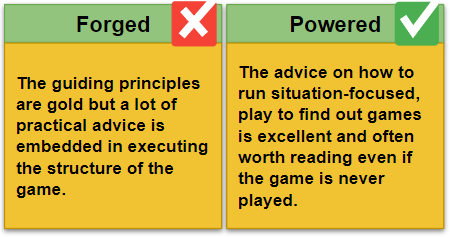
PbtA books, at least in the ones I’ve read, tend to give practical tools and techniques for playing to find out whether it’s how to construct a Monster of the Week mystery or using things like fronts in Dungeon World. In both cases, they are variations on tools to plan via situations without being prescriptive on how things are going to play out. It’s great to tell people to use situations without expected routes to a solution but sometimes it’s better to give more concrete techniques of how to do it.
The advice in the FitD books is also great but it’s a bit more principle and guideline-based. I just think there is a bit less to take away from the FitD advice (though those principles are gold) as more of what would be advice is embedded in the execution of the games structure. Now, some people may think that method is better as you can just concentrate on executing the structure with the principles in mind.
It is a very close call.
And, Finally…
Powered by the Apocalypse and Forged in the Dark games are all fascinating because they do take a more aggressive stance on changing the way the tabletop role-playing game should be experienced at the table. This also tends to make them easy to be liked or disliked with not many people falling into the middle ground.
I think everyone should absorb what they have to say, but then I’m a knowledge for the sake of knowledge person so I would say that.
They do also share similarities as they are trying to achieve the same thing in slightly different ways which can be quite significant in terms of whether one or the other appeals to you and in terms of how they play at the table.
I definitely think I should give one or both a spin.

